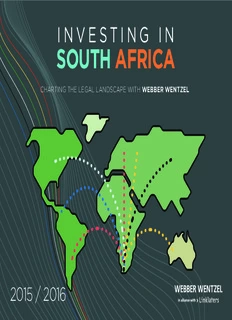
Investing in South Africa – Charting the legal landscape PDF
Preview Investing in South Africa – Charting the legal landscape
I N V E S T I N G I N SOUTH AFRICA CHARTING THE LEGAL LANDSCAPE WITH WEBBER WENTZEL 2015 / 2016 a INTRODUCTION I am proud to introduce the latest edition of Webber Wentzel’s signature publication, Investing in South Africa. A good map is essential when navigating new territory. It helps to formulate meaning and can build a bridge between where you are now and where you want to be tomorrow. This publication is intended to help investors unlock the intricacies of our environment by providing an on-the-ground, tailored perspective of the place we so proudly call home. As one of South Africa’s leading law firms, Webber Wentzel has a long history of assisting clients when investing in our country and further afield on the continent. In fact, together with a network of best-friend law firms, we have been closely involved with many of the most significant deals in South Africa and the rest of sub-Saharan Africa in recent times. I would like to acknowledge and thank those of my colleagues who contributed their time and specialist expertise to assist in the production of this book. I hope you will enjoy reading it as much as we enjoyed compiling it. Haydn Davies | Partner CONTENTS CHAPTER 1 - South Africa – an overview________________________________________________________ 1 CHAPTER 2 - Investment Vehicles & Company Law________________________________________________5 CHAPTER 3 - Employment Law________________________________________________________________9 CHAPTER 4 - Financial Assistance for Investment ________________________________________________ 13 CHAPTER 5 - Securitisation___________________________________________________________________17 CHAPTER 6 - Collective Investment Schemes, Exchange Traded Funds & Hedge Funds__________________ 21 CHAPTER 7 - Trade Relations & Trade Remedies__________________________________________________25 CHAPTER 8 - Financial Services, Financial Markets & Market Abuse__________________________________ 29 CHAPTER 9 - Banking Regulation & Supervision__________________________________________________ 33 CHAPTER 10 - Exchange Control_______________________________________________________________ 37 CHAPTER 11 - Taxation & Double Taxation Agreements_____________________________________________41 CHAPTER 12 - Money Laundering & Anti-Corruption_______________________________________________ 45 CHAPTER 13 - Competition____________________________________________________________________49 CHAPTER 14 - Intellectual Property_____________________________________________________________ 53 CHAPTER 15 - Consumer Protection_____________________________________________________________57 CHAPTER 16 - Protection of Personal Information_________________________________________________ 61 CHAPTER 17 - Broad-Based Black Economic Empowerment_________________________________________65 CHAPTER 18 - Insurance______________________________________________________________________ 69 CHAPTER 19 - Dispute Resolution______________________________________________________________ 73 CHAPTER 20 - Public Law_____________________________________________________________________77 CHAPTER 21 - Environmental Law______________________________________________________________ 81 CHAPTER 22 - Mining & Mineral Law____________________________________________________________ 85 CHAPTER 23 - Real Estate Law______________________________________________________________89 c CHAPTER 24 - Media & Communications, Telecommunications & Broadcasting Law______________________ 93 CHAPTER 25 - Aviation Law____________________________________________________________________ 97 CHAPTER 26 - Project Development & Finance____________________________________________________ 101 CHAPTER 27 - Renewable Energy_______________________________________________________________ 105 CHAPTER 28 - Business Rescue_________________________________________________________________ 109 CHAPTER 29 - Good Corporate Citizenship________________________________________________________ 113 CHAPTER 30 - Oil & Gas________________________________________________________________________117 Please note In the interest of environmental sustainability, this publication only contains the overviews of the various chapters. To access the full copy, we have provided you with a QR code for each chapter; simply scan the relevant code and read the relevant chapter on your smart device. In order to do this you will need to download a QR scanner from your app store. The majority of these scanners are free to download. APPLE WINDOWS apple.com/itunes/ windowsphone.com/en-za/store BLACKBERRY ANDROID blackberry.com/apps play.google.com/store Alternately, please visit www.investinginsouthafrica.co.za 1 1 SOUTH AFRICA – AN OVERVIEW Ashleigh Blair and Johnathan Leibbrandt 1 The Republic of South Africa, a multiparty, constitutional democracy, is situated on the southernmost tip of the African continent. With a population of approximately 54 million people, close to 60% of whom are under the age of 35, it is a young, stable democracy. The country’s legal system is based on Roman-Dutch law, influenced by English law, and is subject to the Constitution of the Republic of South Africa, 1996, as the supreme law. South Africa’s economy has been completely overhauled since the advent of democracy in 1994. The country’s abundance of natural resources (valued in 2010 by Citigroup at US$2.5 trillion, the largest in the world); well- developed and highly regarded banking and financial sector; growing manufacturing and renewable energy sectors; and considerable tourism potential, all contribute to its vibrant emerging market economy. South Africa is a member of, among others, the Southern Africa Customs Union, the Southern African Development Community, the World Trade Organisation, and the African Development Bank. In 2011 South Africa joined Brazil, Russia, India and China in the political grouping of leading emerging economies that has since become known as BRICS. 2 South Africa’s inclusion in the group has thrust it into the league of the world’s fastest-growing and potentially most influential group of nations. South Africa will also benefit from its participation in the US$100 billion New Development Bank (formerly referred to as the BRICS Development Bank) and, in addition, a reserve currency pool worth over US$100 billion. Key targets for South Africa’s growth towards 2030, and the steps required to achieve them, have been articulated in the National Development Plan that was released by the South African National Planning Commission in November 2011. The country’s abundance of natural resources (valued in 2010 by Citigroup at US$2.5 trillion, the largest in the world); well-developed and highly regarded banking and financial sector; growing manufacturing and renewable energy sectors; and considerable tourism potential, all contribute to its vibrant emerging market economy. 3 2 4
Description: